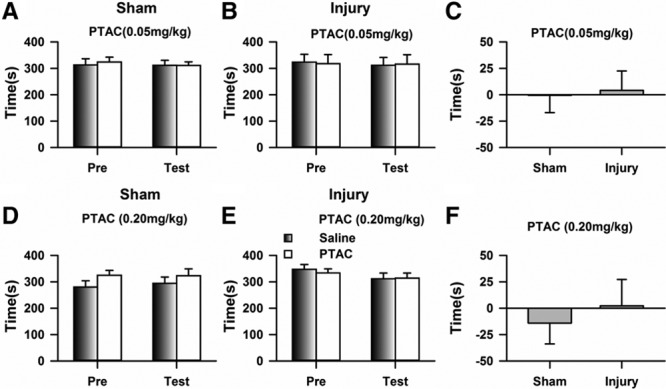Figure 3.

Systematic application of (5R,6R)6-(3-propylthio-1,2,5-thiadiazol-4-yl)-1-azabicyclo[3.2.1] octane (PTAC) did not induce a place preference for the chemical-paired chamber. A, Mice with sham treatments spent equal times in the chambers during the preconditioning and testing periods (2-way RM ANOVA, pre versus test: F1;39 = 0.97, P = .35; drug versus saline: F1;39 = 0.07, P = .80, interaction: F1;39 = 0.09, P = .77; n = 10). B, No place preference was detected after the application of PTAC (0.05 mg/kg) to the mice with nerve injuries (2-way RM ANOVA, pre versus test: F1;35 = 0.02, P = .90; drug versus saline: F1;35 = 0.01, P = .91, interaction: F1;35 = 0.18, P = .68; n = 9). C, No difference was detected in the preference times of the sham and injury groups (t test, P > .05). D, Application of PTAC (0.20 mg/kg) did not induce a place preference in mice with sham treatments (2-way RM ANOVA, pre versus test: F1;39 = 9.54, P < .05; drug versus saline: F1;39 = 0.02, P = .99, interaction: F1;39 = 0.37, P = .56; n = 10). E, No place preference was detected after the application of PTAC (0.20 mg/kg) to the mice with nerve injuries (2-way RM ANOVA, pre versus test: F1;39 = 0.29, P = .60; drug versus saline: F1;39 = 1.01, P = .34, interaction: F1;39 = 0.17, P = .69; n = 10). F, Preference time of mice with sham treatments was similar to that of the injury group during the test period (t test, P > .05). ANOVA indicates analysis of variance; RM, repeated measures.
